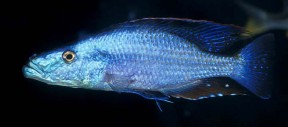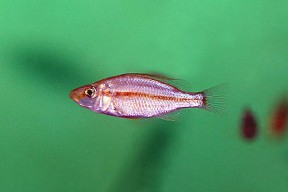Dimidiochromis compressiceps
Malawi Eye-Biter
Classification
Cichlidae. Subfamily: Pseudocrenilabrinae
Distribution
Endemic to Lake Malawi, where it’s widely distributed.
Habitat
Usually found in areas of shallow water in and around patches of submerged vegetation..
Maximum Standard Length
10″ (25cm).
Aquarium SizeTop ↑
60″ x 15″ x 18″ (150cm x 37.5cm x 45cm) – 250 litres.
Maintenance
Set up the aquarium with piles of rocks arranged to form caves, large areas of open water for swimming and preferably a sandy substrate. Planting with Vallisneria in dense patches would simulate the natural habitat of the species. There should be no strong current in the tank.
Water Conditions
Temperature: 73-82°F (23-28°C)
pH: 7.5-8.8
Hardness: 10-25°H
Diet
Will accept dried foods such as pellets but these should not form the basis of the diet. Although this fish is a piscivore by nature, it can easily be trained to accept dead foods in captivity. Prawns, mussel, cockle, lancefish etc. can all be offered.
Behaviour and CompatibilityTop ↑
A predatory species with a large mouth that should not be kept with fish under around 5″ in length, as these will be eaten. It’s peaceful enough with species too large to eat. The males only become territorial during spawning. Keep several females per male.
Sexual Dimorphism
Adult males are much more colourful than females, which are predominantly a plain silvery colour.
Reproduction
Not easy. Polygamous maternal mouthbrooder.
The breeding aquarium shouold be at least 60″ in length. This should be furnished as suggested above with the addition of some large, flat rocks to provide potential spawning sites and areas of planting with Vallisneria. A pH of 8.0-8.5 and a temperature between 77-81°F are ideal.
A breeding group of one male and 3-6 females is recommended, as males can be quite hard on individual females. When ready the male will choose a spawning site, either on a flat rock surface or by digging a depression in the substrate. He will display around this, showing intense colour, and attempt to entice females to mate with him. When a female is willing, she will approach the spawning site and lay her eggs there, after which she immediately picks them up in her mouth. The male fish has egg-shaped spots on his anal fin and the female is attracted to these. When she tries to add them to the brood in her mouth she actually recieves sperm from the male, thus fertilising the eggs.
She will carry the brood of up to 250 eggs (usually 40-100) for around 3 weeks before releasing the free swimming fry. She will not eat during this period and can be easily spotted by her distended mouth and brooding colouration of dark patterning. Female D. compressiceps are notorious for spitting out the brood early when stressed, so extreme care must be taken if you decide to move the fish. It is also worth noting that if a female is away from the colony for too long she may lose her position in the pecking order of the group. It’s best to wait as long as possible before moving a female unless she is being harassed by her tankmates.
Some breeders artificially strip the fry from the mother’s mouth at the 2 week stage and raise them artificially from that point. This usually results in a larger number of fry, but is an approach recommended only to those with previous experience handling fish. In either circumstance the fry are large enough to accept brine shrimp nauplii from the day they are free swimming/released by the mother.
NotesTop ↑
D. compressiceps is an ambush predator in nature, its laterally compressed shape and head-down hunting position allowing it to remain hidden among Vallisneria beds and making it tricky to spot in open water. It has a dark stripe running from the snout along the back to the tail which serves to provide further camouflage.
Despite its common name, it does not prey solely on the eyes of other species, preferring to hunt small fish (particularly juvenile Copadichromis sp.). It swallows these tail first, the only known species of predatory fish consume prey this. Its common name is derived from its habit of eating the eyes of fish in nature. This happens infrequently and there are various theories surrounding it. Some suggest that it is blinding its prey, others think that it only occurs when food is scarce, whilst yet others suggest the eye may be a delicacy of some kind. In any respect, this will rarely, if ever, happen in aquaria with well-fed specimens.
An albino form is occasionally available in the hobby, and has become more popular in recent years.


